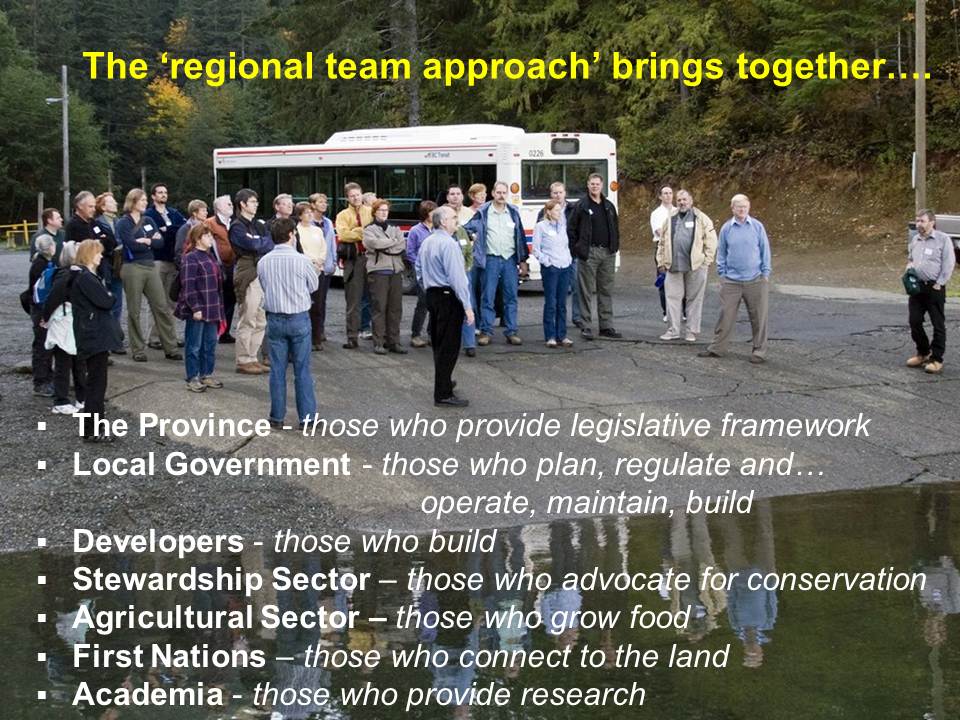CHAMPION SUPPORTER: Comox Valley Regional District (December 2012)
About the Comox Valley Regional District
The Comox Valley Regional District (CVRD) is a federation of three electoral areas and three municipalities providing sustainable services for residents and visitors to the area. The members of the regional district work collaboratively on services for the benefit of the diverse urban and rural areas of the Comox Valley.
The geography of the CVRD includes rural agricultural, vibrant urban, meandering coastline and dramatic mountains.
The CVRD covers an area of 2,425 square kilometres, of which 1,725 square kilometres is land (the remainder is water), and serves a population of 63,538 according to the 2011 Census.
The CVRD was established in February 2008, following the restructure of the Comox Strathcona Regional District into two: Comox Valley Regional District and the Strathcona Regional District.
Convening for Action on Vancouver Island
Since 2009, the CVRD has been a champion for the CAVI-Convening for Action on Vancouver Island initiative. The CVRD is a member of the Comox Valley Regional Team and hosted and chaired the 2009 Comox Valley Learning Lunch Seminar Series. The regional team comprises representatives of the City of Courtenay, Town of Comox, Village of Cumberland, Comox Valley Land Trust, TimberWest, and Partnership for Water Sustainability in BC. The Courtenay representative (Derek Richmond) is also CAVI Chair.
 “CAVI began as a grassroots collective partnership committed to achieving settlement in balance with economy and ecology, starting with water-centric planning. CAVI was formally launched in 2006 at a consultation workshop held in conjunction with the Water in the City Conference,”states John Finnie, CAVI Past-Chair (2006-2011).
“CAVI began as a grassroots collective partnership committed to achieving settlement in balance with economy and ecology, starting with water-centric planning. CAVI was formally launched in 2006 at a consultation workshop held in conjunction with the Water in the City Conference,”states John Finnie, CAVI Past-Chair (2006-2011).
“The CAVI program is currently being implemented under the umbrella of the Partnership for Water Sustainability in British Columbia. CAVI continues to reach out to groups that share a vision for Vancouver Island, with the goal of creating a roundtable of partnerships.”
To Learn More:
The story of CVRD’s contribution to the ongoing success of the CAVI-Comox Valley Regional Team is told elsewhere on the waterbucket.ca website. Click on Getting Ahead of the Wave: An Integrated Watershed Approach to Settlement to read about the 2009 Learning Lunch Seminar Series.
Comox Valley Regional District is a Champion Supporter of the Partnership for Water Sustainability
 “The Champion Supporter designation is the Partnership’s way of formally recognizing government and non-government organizations that provide the Partnership with ongoing financial and/or in-kind support; and also play a leadership role in the ‘convening for action’ initiative,” wrote Kim Stephens, Partnership Executive Director.
“The Champion Supporter designation is the Partnership’s way of formally recognizing government and non-government organizations that provide the Partnership with ongoing financial and/or in-kind support; and also play a leadership role in the ‘convening for action’ initiative,” wrote Kim Stephens, Partnership Executive Director.
Inter-Regional Education Initiative
“In February 2012, we asked the Comox Valley Regional Board for their support so that we could bring together three other regional districts and initiate the Inter-Regional Education Initiative on Rainwater Management in a Watershed Sustainability Context (IREI). We also asked that the CVRD be the lead regional district. The Board agreed to both requests. This provided us with the early momentum necessary to bring the IREI to fruition.”
“Significantly, the 2012 set of Comox Valley regional team working sessions constituted ‘proof of approach’ for the IREI. We also organized a flagship event in each of the other three partner regional districts. The experience we gained will help facilitate full-scale implementation on both sides of the Georgia Basin in 2013 and beyond,” concludes Kim Stephens.
 “Inter-regional sharing, collaboration, alignment and consistency will accelerate effective implementation of watershed protection objectives within each regional district. The regions are linked by common interests, but are not dependent on each other,” states Comox Valley Board Chair Edwin Grieve.
“Inter-regional sharing, collaboration, alignment and consistency will accelerate effective implementation of watershed protection objectives within each regional district. The regions are linked by common interests, but are not dependent on each other,” states Comox Valley Board Chair Edwin Grieve.
“This important initiative will help assist the regional district as we move forward and address rainwater management issues in the Comox Valley. It also aligns with our Board strategic priority to develop a rainwater strategy.”
Need for Integrated Inter-Basin Approach
“In August 2011, the Comox Valley Regional Board passed a series of resolutions pertaining to an integrated watershed approach to rainwater management. These resolutions highlighted the need for province-wideaction related to how drainage is regulated by the Ministry of Transportation and Infrastructure,” adds Debra Oakman, CVRD Chief Administrative Officer.
 In a report to the Board, Debra Oakman wrote: “There are a number of issues related to stormwater and drainage that require coordination between the regional district, member municipalities and the provincial government. Analysis and recommendations on improvements are needed to ensure that the processes and requirements of the CVRD and MoTI are effective, follow best management practices and that no gaps in responsibility are present.”
In a report to the Board, Debra Oakman wrote: “There are a number of issues related to stormwater and drainage that require coordination between the regional district, member municipalities and the provincial government. Analysis and recommendations on improvements are needed to ensure that the processes and requirements of the CVRD and MoTI are effective, follow best management practices and that no gaps in responsibility are present.”
“While stormwater and drainage issues are often dealt with on a case by case basis, an integrated basin-wide approach is ultimately required to handle issues that affect all local governments within the CVRD,” concluded Debra Oakman.
Agricultural Water Demand Model
“The Comox Valley Regional District is also collaborating with the Partnership for Water Sustainability to implement the Vancouver Island  Agricultural Water Demand Model,” reports Ted van der Gulik, Senior Engineer with the BC Ministry of Agriculture.
Agricultural Water Demand Model,” reports Ted van der Gulik, Senior Engineer with the BC Ministry of Agriculture.
“Many BC watersheds are either already fully allocated or will be in the next 15 to 20 years. The model provides information on current agricultural water use and will also determine future use under various climate change scenarios. It will also be used to fulfil the province’s commitment under the Living Water Smart strategy, to reserve water for agricultural lands. It enables scenario comparisons to assess the implications and impacts of a changing climate, in particular warmer winters and longer summers.”
To Learn More:
Click on Towards Food Security on Vancouver Island: Agricultural Water Demand Model is a Key Tool.





